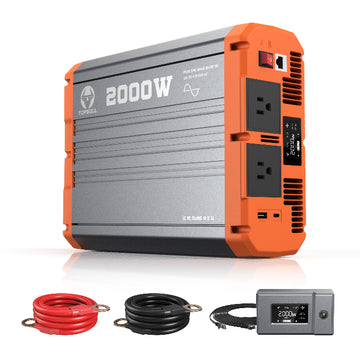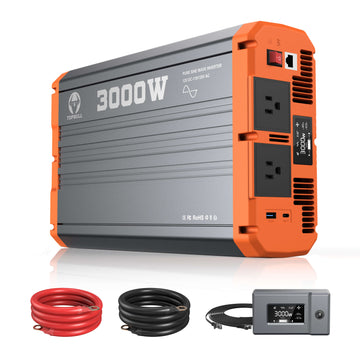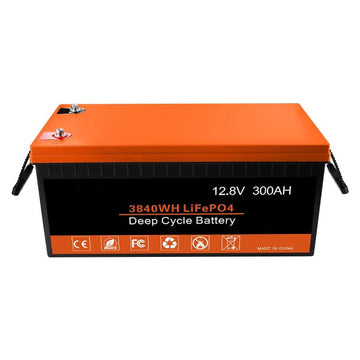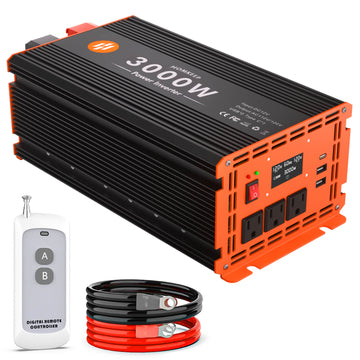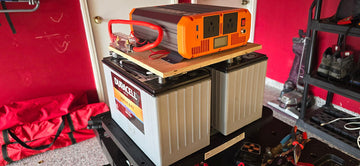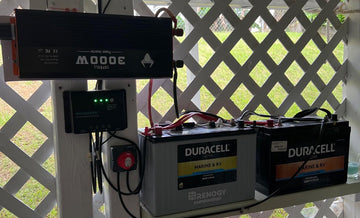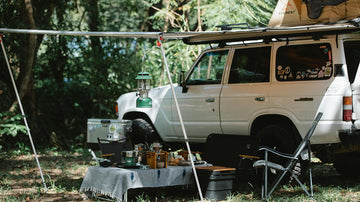If your inverter suddenly shuts down, overheats, or fails to power your equipment, you're not alone. Over 60% of inverter failures stem from preventable problems such as loose connections, overloaded circuits, or poor maintenance.
This guide takes an in-depth look at the most common power inverter problems faced by users and provides actionable solutions backed by specialized knowledge.
By the end of the article, you will know exactly how to do it.
- Fix inverters that won't turn on
- Stops overheating and unstable power output
- Fix inverter noise problems
Why won’t my power inverter turn on?
If the power inverter fails to start, it may leave you in a no-power state. This situation can be caused by some fixable issues, which you can troubleshoot and complete as described below.
Batteries are dead or undercharged.
The connection between the inverter and the battery is critical. Corroded terminals or loose connections can affect its power supply. If the connections look normal, the battery voltage may be too low. If the battery voltage falls below the minimum requirement of the inverter (typically 10.5V for 12V systems), the inverter will automatically shut down to protect itself.
Solution:
- Clean the terminals with a mixture of baking soda and water, then tighten all cables securely.
- 2. Use a multimeter to test the battery voltage. A reading below 11V indicates a severely depleted or aged battery. It is recommended that the battery be recharged.
If the battery is old or will not hold a charge, consider replacing it with a deep cycle model designed for inverters.
Blown fuse or tripped circuit breaker
Inverters have built-in fuses or circuit breakers to protect against overloads. A sudden power surge or excessive load can blow a fuse or trip a circuit breaker, which can cut off the system. When connecting equipment daily, be sure to watch the total power and not exceed what the inverter can handle.
Solution:
Locate the fuse box (usually near the battery input terminals) and check the fuses. If there is a visible break in the wire or the glass is darkened, the fuse has blown. Replace the fuse with one of the same rating.
Power switch or wiring failure
Mechanical switches and internal wiring deteriorate over time, especially in harsh environments. If the batteries and fuses are OK, test the power switch.
Solution:
- Use a multimeter to check for continuity between the switch terminals when switching. Discontinuity means the switch is defective and needs to be replaced.
- Check internal wiring for worn insulation, loose solder joints, or rodent damage (common in RV and outdoor installations). Resolder or replace damaged wires to restore continuity.
Internal inverter faults
If all external components check out fine, there may be a serious fault in the inverter itself, such as a burnt MOSFET transistor or capacitor failure. Warning signals include:
- Burning odor or visible scorch marks inside the unit.
- Error codes such as “E01” or flashing LEDs (see manual for specific codes).
While basic soldering skills can fix minor problems, extensive internal damage usually requires professional repair or replacement. If it is under warranty, contact the manufacturer.
Why is my inverter overheating or shutting down?
Overheating or accidental shutdown is also a common problem in the use of inverters, which not only affects the performance of the equipment, but also may shorten its life or even cause safety hazards. The following analyzes the root causes from multiple dimensions, such as environmental, electrical, and design, and provides corresponding solutions.
Insufficient heat dissipation and high-temperature environment
Inverter internal electronic components generate a lot of heat when working. If the heat dissipation system fails or the installation environment is poor, the heat can not be discharged in time, the temperature will accumulate rapidly. Overheating of the inverter will trigger the protection mechanism and force shutdown. Common triggers include:
- Poor ventilation: Narrow space around the inverter (e.g. wall mounting), or air ducts blocked by dust or lint, resulting in obstructed airflow.
- Direct sunlight: Inverters installed outdoors without shading measures, the shell receives direct sunlight to increase the temperature and intensify the pressure on internal heat dissipation.
- High humidity or dusty environment: Humidity or dust intrusion into the interior of the device may corrode the circuit board or cover the heat sink, reducing the efficiency of heat conduction.
Solution:
- Ensure that the installation location is well ventilated by reserving at least 5cm of space on both sides and more than 30cm above and below, and regularly clean the air ducts and heat sinks.
- Install shades or cooling fans in high-temperature areas (e.g., rooftops or desert climates), and use air conditioners to force down the temperature if necessary.
- Choose an inverter with good heat dissipation to prevent dust and moisture intrusion.
Recommended: Topbull pure sine wave inverter, 100% pure copper material + dual intelligent temperature control fans

Overload and wiring problems
Although inverters are designed with overload protection, prolonged overload operation can still cause components to overheat. For example, an inverter with a rated power of 5kW that continuously outputs 6kW may see its internal temperature rise at a rate of 2-3°C per minute, eventually triggering a protection shutdown. In addition, poor electrical connections can also trigger localized high temperatures:
- Overloaded operation: the PV module generates more power than the inverter capacity, or the total power of the load equipment exceeds the inverter rating39.
- Loose or corroded wiring: poor contact at battery terminals, DC input terminals increases resistance and generates Joule heat
Solution:
- Reasonably match the inverter to the system capacity and reserve 10-15% power redundancy.
- Regularly check terminals, clean corroded battery connectors with a baking soda solution, and make sure all connections are tight.
Why does the inverter show low/no battery charge?
An inverter displaying a low or no battery warning usually means that the energy storage system is unable to provide enough energy to the load. The problem may be related to the condition of the battery itself, a faulty charging system, or abnormal environmental conditions.
Aging or declining battery capacity
The battery is the core energy storage unit of the inverter system, and its lifespan is affected by the number of charge/discharge cycles, ambient temperature, and usage habits. Lead-acid batteries may lose up to 80% of their nominal capacity after more than 500 charging and discharging cycles, while lithium batteries decay slowly, but improper use (e.g., over-discharging to less than 20%) can accelerate aging.
Solution:
Regular equalization charging (lead-acid batteries every 3 months, lithium batteries are automatically equalized by BMS) to ensure consistent voltage of single unit.
Ambient temperature impact
Battery performance is highly sensitive to temperature. Lead-acid batteries lose about 30% of their capacity below 0°C, while lithium batteries lose 50% of their discharge efficiency at -10°C. High temperatures (>35℃) then accelerate electrolyte evaporation and polar plate sulfation, resulting in a sudden drop in usable power.
Solution:
- Add insulation to the battery pack in winter.
- In summer, control the battery temperature within 25±5℃ by forced air cooling or phase change materials.
Mismatch between system configuration and load
The imbalance between battery capacity and load power is a common trigger for power alarms. If the actual load exceeds the design value, the battery will frequently enter a deep discharge state.
Solution:
- Control the number of devices connected to ensure that the total power does not exceed 80% of the rated value of the inverter.
- Recalculate the system configuration, select the battery capacity according to the principle of “load power x 1.2,” and reserve 20% redundancy.
Learn More: What Size Inverter Is Suitable for a House?
Corroded or loose terminals
Oxidized battery terminals can significantly increase contact resistance, leading to voltage drops and false charging. It may also cause the inverter to fail to turn on (mentioned above). The treatment is the same as above.
Why is the output power low or unstable?
Weak or unstable power inverter outputs can interfere with critical equipment such as medical devices, refrigerators, or communication systems. Such problems usually stem from mismatched configurations, component degradation, or environmental factors.
Insufficient battery capacity or aging batteries
Battery health directly affects output stability. Depleted or aged batteries cannot maintain the voltage required for stable inverter operation. For example, a 12V battery that drops below 10.5V under load will force the inverter to throttle the output, causing the voltage to plummet. Lead-acid batteries that have been charged more than 500 cycles often develop internal sulfation, reducing the usable capacity by 30-50%.
The solution is the same as above.
Inverter overload or surge demand
Inverters have strict continuous and surge power ratings. Exceeding these limits, even briefly, can cause output instability. Induction motors (e.g., air conditioners) require 3-7 times their rated power at startup, and if the inverter lacks sufficient surge capacity, the protection circuit may trip.
Solution:
- Use a clamp meter to measure the peak inrush current. Compare this to the inverter's surge power rating,
- Install a soft starter for the motor to reduce the starting surge by 70%.
- For mixed loads, prioritize high surge devices on a separate inverter or use a hybrid inverter with dual-mode operation.
Why is the inverter making strange noises?
Abnormal sounds (e.g. beeps, clicks, high-frequency whistles) emitted during operation of the inverter are often early warning signals of malfunction. These sounds may be triggered by mechanical vibration, electromagnetic interference, or component aging and may evolve into permanent damage if not handled in time. In the previous article, the causes of inverter rattling have been analyzed in detail. Click to view

